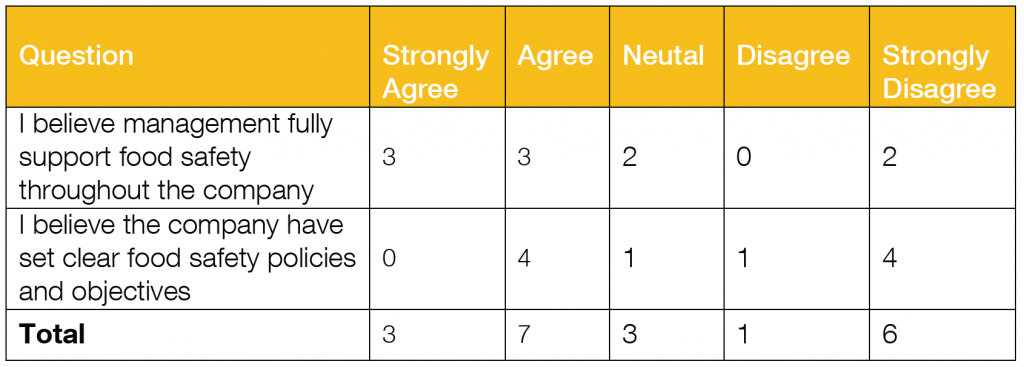Overview of Food Safety Culture Survey Results
1. Questionnaire
The 4C Food Safety Culture Questionnaire has been developed employing Bipolar questions which are used to determine the respondent’s intensity of feelings based on two opposite dimensions. These are Like to dislike. The scale adopted is a Likert Scale covering, Strongly Agree, Agree, Neutral, Disagree and Strongly Disagree. The Likert Scale adopts positive based questions to allow the analysis of results using a average score.
2. Average
Average is where a ‘rate’ is assigned to each answer chosen and the results can be used to calculate a average. An example being:
Rating used in the enlighten questionnaire.

The following is an overview of how to calculate the average where the questionnaire has 2 questions and 10 respondents.
Summary of respondents to the questionnaire with two questions.

We can now work out the average, as follows:

The average is calculated using the following formula:
Average = Total W x R / Total Respondents
Average = 60/20 = 3.0
As the questionnaire uses positive based, bipolar questions the results can be interpreted as 5 = to a very positive Food Safety Culture and 1 = to a very negative Food Safety Culture. The average score can be further interpreted using the enlighten Food Safety Culture Risk Framework
3. Reports
enlighten generates two reports, the Culture Report, which calculates the average and can be filtered using the following criteria
- Company – Covering all respondents
- Categories – Allowing filtering on the 4C model, which is- Control, Cooperation, Communication and Competency
- Role – Allowing filtering by Senior Management, Management and Supervisor, Operative and Technical/QA.
- Language – English speaking and non-English speaking
The second is the average report which calculates the average of individual questions used in the survey and can be filtered using the same criteria as the Culture Report.
4. Significance Testing
Where an organisation has undertaken two Food Safety Culture surveys and would like to determine if there is a significant variance between the results, enlighten has adopted the Welch’s t-test, which is also known as the Unequal Variances t-test. The purpose of the Welch’s t-test is to compare the current survey results with the previous survey results and determine where there is a variance in the rating.
The following is a worked example of a Food Safety Culture Average Report which explains the significance testing in more detail:
Food Safety Culture Average Report
Although we have a variance of minus 0.3 on question 1 the Welch’s t-test has determined this is not a significant variance. This shows that there has been neither a significant improvement or decline in this area.
However, on Question 2 we have a variance of plus 1.3 and the Welch’s t-test has determined this as significant which indicates there has been a considerable improvement in this area. However, when reviewing variances, it is important to determine if the variance is negative or positive.